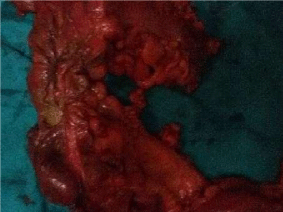
Case Presentation
Austin Surg Case Rep. 2017; 2(1): 1014.
Isolated Perforation of Ascending Colon Following Blunt Abdominal Trauma: Case Report with Review of Literature
Sathanantham DK, Amit Mittal, Sreeramulu PN, Srinivasan and Aishwarya MS*
Department of General Surgery, Sri Devraj Urs Medical College, India
*Corresponding author: Aishwarya MS, Department of General Surgery, Sri Devraj Urs Medical College, India
Received: March 27, 2017; Accepted: April 20, 2017; Published: April 28, 2017
Abstract
Introduction: Large bowel perforations are rare but are associated with high morbidity and mortality. The common causes for large bowel perforation are colon carcinoma and diverticulosis. Mortality and morbidity is related to the extent of fecal peritonitis. Nonmalignant causes are associated more often with postoperative complications. Early diagnosis and intervention will prevent serious complications associated with fecal peritonitis.
Case Presentation: A 60 year male patient presented to the ER with history of fall 2 days back with pain abdomen which increased gradually. Initially for 2 days patient was being treated in local hospital before being referred to our hospital. On laparotomy huge perforation noted in the ascending colon extending from caecum to hepatic flexure. Right Hemicolectomy was done along with ileocoloic anastomosis.
Conclusion: Colonic perforation is rare surgical emergencies. Early diagnosis and timely intervention will reduce the mortality associated with colonic perforation.
Reference: Bugis SP, Blair NP, Letwin ER. Management of blunt and penetrating colon injuries. Am J Surg. 1992; 163: 547-550.
Introduction
Large bowel perforation is an acute surgical emergency associated with significant mortality and morbidity [1]. The common sites for perforation in GIT is – stomach and small intestine, large bowel perforation is a rare entity. Large bowel has a rich blood supply from the branches of aorta i.e., superior and inferior mesenteric artery. Superior mesenteric artery supplies from the 2nd part of duodenum up to 3/4th of the transverse colon. Inferior mesenteric artery supplies the distal 1/3rd of transverse colon up to upper third of the anal canal [2]. The common causes for penetrating bowel injury are gunshot injury, stab injury, blunt trauma and foreign body. Mechanism of perforation is either due to compression or deceleration. Transverse colon and sigmoid are more vulnerable due to deceleration injury. Blunt trauma abdomen accounts for 1% of all hollow viscous perforation and incidence of large bowel injury is 0.3%. Colon - rectal injury secondary to blunt trauma is a diagnostic challenge [3]. Diagnosis is made at the time of laparotomy in majority of the cases.
Case Presentation
A 60 year male patient presented to the emergency department with 2 days history of fall with pain abdomen of 2 days. Patient was initially treated in a local hospital for 2 days before being referred to our hospital. At the time of presentation patient was conscious, irritable had tachycardia and BP was 120/70mmHg, SpO2 was maintained at room air. On examination, the patient had distended abdomen with features of peritonitis. Erect X ray abdomen showed air under the diaphragm (Figure 1). Peroperatively peritoneal cavity was contaminated with fecal matter and colon was found to be loaded. A linear perforation measuring 3 inches noted at the ascending colon with macerated edges. The wall of the ascending colon was indurated. In view of this finding emergency right hemicolectomy was done with ileo-transverse colon anastomosis. Postoperatively patient recovered well. Bowel sounds returned on day 4 with no wound infection (Figure 2). Patient developed cardiac arrhythmias on day 3 and continued till day 5 leading to death of the patient.

Figure 1:

Figure 2:
Discussion
Large bowel injury is misleading in majority of the cases and associated with high mortality and morbidity [1]. Unprepared bowel, sepsis, anemia and electrolyte disturbances are the factors associated with poor prognosis. Colonic injuries are divided surgically into V grades (Table 1).
Grade
Characteristics Of Injury
Colon
1
Contusion Or Hematoma
2
Small (<50% Of Circumference)
3
Large (>50% Of Circumference)
4
Transection
5
Transection With Tissue Loss; Devascularised Segment
Table 1: Colonic injuries grades.
Grade 4 and 5 are treated with ileostomy or colostomy. The primary modalities of treatment of colonic perforation are – proximal diversion and repair, colostomy, primary closure and resection and anastomosis [4]. Resection and anastomosis is advised if the patient is hemodynamically stable, with well vascularized bowel and if there is not much of contamination [5]. Many of the perforations can be closed with primary closure, only rarely resection and anastomosis is required.
Conclusion
Large bowel perforation is a surgical emergency. Early diagnosis and management of large bowel perforation will reduce mortality and morbidity. The nature of surgery will depends on the grade, site of injury and peritoneal contamination noted on laparotomy.
References
- Posture related discomfort.
- Heffernan C, Pachter HL, Megibow AJ, Macari M. Stercoral colitis leading to fatal peritonitis: CT findings. AJR Am J Roentgenol. 2005; 184: 1189–1193.
- Terminology FCoA: Terminologia anatomica: International anatomical terminology. Ney York. 1998.
- Williams MD, Watts D, Fakhry S. Colon injury after blunt abdominal trauma: results of the EAST multi-institutional hollow viscus injury study. J trauma. 2003; 55: 906-912.
- Demetriades D, Murray JA, Chan LS, et al. Handsewn versus stapled anasstamosis in penetrating colon injuries requiring resection: a multicenter study. J trauma. 2002; 52: 117-121.
- Nespoli A, Ravizzzini C, Trivella M, Segala M. The choice of surgical procedure for peritonitis due to colonic perforation. Arch surg. 1993; 128: 814-818.